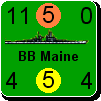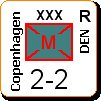Extraneous
Posts: 1810
Joined: 6/14/2008
Status: offline

|
.P These write-ups give a brief history of one or more vessels from each of the
main classes of submarine used by the Kriegsmarine during World War II. World In
Flames submarine counters represent a number of submarines rather than any
specific individual boat. The dates printed on the back of the counters do not
tie up in any meaningful way with build dates for the various classes of German
submarine, and therefore the counter date in most cases should be ignored.
.P During the First World War the submarines of the Kaiser's navy came close to
starving the United Kingdom into surrender. Following Germany's defeat, their
entire submarine fleet was handed over to the Allies and the German navy was
forbidden to use submarines in future.
.P Secretly however, the Germans continued to work on new designs - and indeed in
the late twenties, German designed submarines were sold to Turkey and Finland via
a "Dutch" company operating in Holland.
.P Development of designs and ideas continued until, in March 1935, Adolf Hitler
formally repudiated the Treaty of Versailles. Germany then openly set about
re-arming her armed forces, including the Kriegsmarine.
.P Shortly after this announcement, the German and British Governments signed the
Anglo-German Naval Agreement. Under the terms of this treaty, the German navy was
allowed to build a fleet no greater than 35% of the Royal Navy's total tonnage.
Subject to this limitation, the Kriegsmarine's submarine service was allowed to
equal that of the Royal Navy.
.P Despite this, at the outbreak of World War II in September 1939, the
Kriegsmarine's submarines (in German Unterseeboot or simply U-boat) numbered a
mere fifty-seven boats - the same as the Royal Navy. Of these, only twenty-six
were suitable for Atlantic operations. However, the Germans soon embarked upon a
huge expansion program and during the war, well over 1,000 boats were
constructed.
.P There were some spectacular early successes; the sinking of the battleship
Royal Oak and the aircraft carrier Courageous ranking high amongst them. Later,
when U-boats were deployed in the Mediterranean, further success was achieved
against the Royal Navy; the Fleet carrier Ark Royal and the battleship Barham were high
profile victims to the power of the U-boat.
.P But it was the outcome of the Battle of the Atlantic upon which the U-boat arm
would be ultimately judged, and early in the war, successful attacks on Allied
merchant shipping proved a severe problem for the British. With the conquest of
Norway, and in particular, France by June 1940, the U-boats were able to operate
from ports that gave much easier access to the Atlantic and extended the time
they could be operational against enemy shipping. Dönitz was gradually able to
field more and more U-boats, and these were grouped into "wolf packs" to ensure
that convoys, when spotted, could be attacked by many boats at the same time.
.P Winston Churchill said that the Battle of the Atlantic - and in particular the
U-boat menace - was the only thing that scared him during World War II; with the
serious merchant ship losses incurred from mid 1940 until early 1941 (known by
the U-boat crews as the first "Happy Time") it is easy to see why. There was to
be a second, albeit brief, "Happy Time" after the United States entered the war
in December 1941. But by then, many of the seeds that would ultimately break the
U-boats had been sown. From 1943 the Allied ability to build merchant shipping
easily outstripped losses.
.P Ultimately the Allies were able to beat the U-boats for a number of reasons:
there was the convoy system and the sheer number of escorts that the Allies were
able to field; the Allies were able to maintain the pace of technological
advances to improve their ability to conduct anti-submarine warfare; conventional
escort ships, such as destroyers and corvettes, were later supplemented by escort
aircraft carriers that could provide a measure of air protection to a convoy; and
last but not least, aircraft - which were the U-boats greatest enemy - were able
to fly from the United Kingdom, Iceland and later Canada, meaning that the entire
convoy route across the North Atlantic could be covered by aircraft.
.P By late 1942, although the U-boats were still sinking plenty of Allied
shipping, the cost to the Kriegsmarine in terms of men and boats, was growing.
Many believe that the turning point of Dönitz and his U-boats versus the convoys followed the attacks in March 1943 by three Kriegsmarine wolf packs against convoys SC122 and HX229. It was after the U-boat success against these two convoys that Liberator aircraft were operated out of Canada, escort carriers began to become available, and more escort groups were formed.
.P Germany was simply not geared up to fight a long war, the resources available
to counter the Allies were just not available, and the Kriegsmarine's response to
the ever growing Allied threat proved too little, too late.
.P The U-boat service suffered more losses per head than any branch of any
service of any country in World War II. Of the 40,000 men that served in U-boats
during the conflict, no less than 28,000 were killed and a further 8,000 were
taken prisoner.
Types of aircraft carriers
_____________________________
University of Science Music and Culture (USMC) class of 71 and 72 ~ Extraneous (AKA Mziln)
|
 Printable Version
Printable Version

 and pick out a handful of your favorite naval units and/or naval unit write-ups. Maybe 5 or 6 will do. Since you are so good about posting your write-ups here, I want to make screenshots of your favorites so that people can see what they actually look like once they are in the game. Is that okay with you?
and pick out a handful of your favorite naval units and/or naval unit write-ups. Maybe 5 or 6 will do. Since you are so good about posting your write-ups here, I want to make screenshots of your favorites so that people can see what they actually look like once they are in the game. Is that okay with you? 













 to see some of the others. If there are any specific units you are interested in, I'll try to post them as time permits. I've never gone through all 70+ pages, so I don't know for certain if a unit is up or not.
to see some of the others. If there are any specific units you are interested in, I'll try to post them as time permits. I've never gone through all 70+ pages, so I don't know for certain if a unit is up or not. 



 "Centre" is spelled correctly. They are doing the writeups in the Queens english not American english.
"Centre" is spelled correctly. They are doing the writeups in the Queens english not American english.  New Messages
New Messages No New Messages
No New Messages Hot Topic w/ New Messages
Hot Topic w/ New Messages Hot Topic w/o New Messages
Hot Topic w/o New Messages Locked w/ New Messages
Locked w/ New Messages Locked w/o New Messages
Locked w/o New Messages Post New Thread
Post New Thread